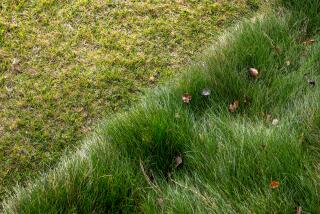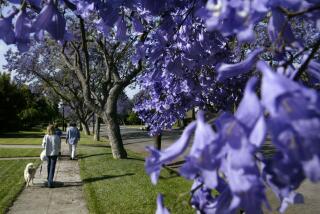Dry Gardening: Evapotranspiration and the over-watering of the Southern California lawn
- Share via
Editor’s note: This is the first installment of a column on drought-tolerant gardening that will appear occasionally in the Home section. For weekly advice and conversation on the subject, go to our new blog at latimes.com/home. In the categories box, click Dry Gardening.
Most of us learn about evapotranspiration in school. Rain or snow falls. As it forms rivers or soaks into the earth, a certain amount of it evaporates into the atmosphere. That’s the “evapo” part. Then the roots of plants also absorb water from the earth and feed it to their leaves. During photosynthesis it is released back into the atmosphere. That’s the “transpiration” part.
How fast evapotranspiration occurs and how much water is involved depends on a place and its plants. Tropical flora, flushed with steady water, grows in a fast, lush and often continuous fashion. Landscape designers would say it has an high ET rate.
Plants in dry Mediterranean climates such as ours use water sparingly. Faced with bone dry summers, Mediterranean plants typically become dormant in late spring through fall to conserve water.
These plants have low ET rates.
But in Los Angeles, we tend to use plants with high ET rates in a region naturally suited to plants with low ones. Because the climate is simply too hot for most plants with high ET rates, we are forced to water them at many times over the already high rate they would naturally require.
Until new city drought restrictions began in Los Angeles on June 1, the Metropolitan Water District estimated that our garden hoses and sprinklers applied roughly 84 inches of water a year on our gardens. That’s four times the rainfall rate for Honolulu.
Most of that went on lawn, which has such a high ET rate that it typically goes brown in summer even in cold and rainy England. Were we less lawn-proud and closer to the sources of our water supply in Southern California, we might have made more regionally appropriate landscaping choices. But the networks of aqueducts serving us travels hundreds of miles north and east. We’re all but unaware that we’ve pumped three of our major water sources near the point of collapse. To make matters worse, many of our local stores offer mostly high-ET plants such as turf.
To deal with the gathering crisis, Los Angeles issued its ordinance limiting how often we may water our lawns starting June 1. We could, water managers estimate, save a quarter of our total water supply by merely upgrading and turning down our sprinklers.
How do the water wonks know this? The steady ribbon of overflowed sprinkler water running through our gutters all summer is a clue. Yet the calculation mainly derives from looking at the E -rates of turf grass, then looking at how much turf there is and how much water it actually needs.
Suffice it to say that your average L.A. lawn does not need four times the annual average rainfall of Hawaii to survive, even in hot, dry Southern California.
Rather than confuse us with water math, Los Angeles and its Department of Water and Power have decided that our lawns will do just fine being watered twice a week for 15 minutes at a time.
As the restrictions kick in, water companies are also offering incentives for us to upgrade old, wasteful irrigation systems. For more information: www.ladwp.com (click on Rebates & Programs, then Residential Rebates and Programs).
For other rebates, go to the Metropolitan Water District member agency page and follow the links to your supplier: www.mwdh2o.com (click on “member agencies”).
Green also blogs on drought-tolerant gardening and water issues at chanceofrain.com.






